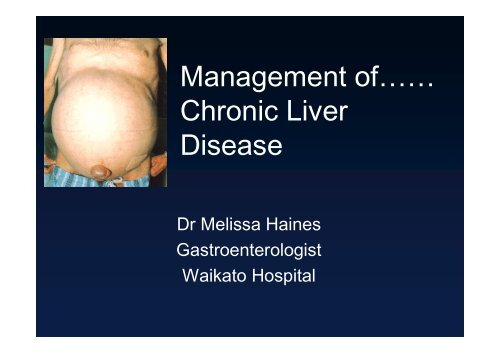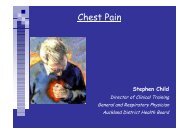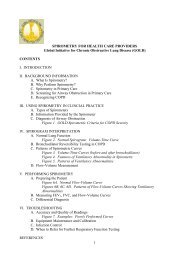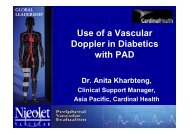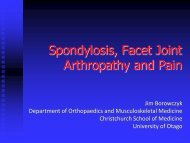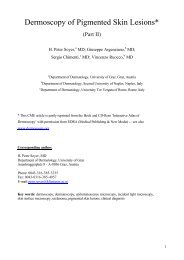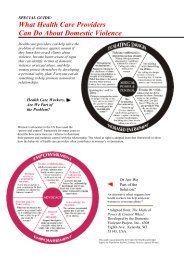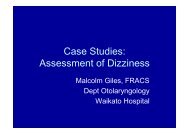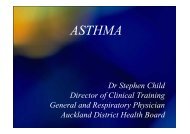Management ofâ¦â¦ Chronic Liver Disease
Management ofâ¦â¦ Chronic Liver Disease
Management ofâ¦â¦ Chronic Liver Disease
Create successful ePaper yourself
Turn your PDF publications into a flip-book with our unique Google optimized e-Paper software.
<strong>Management</strong> of……<br />
<strong>Chronic</strong> <strong>Liver</strong><br />
<strong>Disease</strong><br />
Dr Melissa Haines<br />
Gastroenterologist<br />
Waikato Hospital
Outline<br />
Recognising and diagnosing the patient with<br />
chronic liver disease<br />
Causes of chronic liver disease in NZ<br />
• Investigations<br />
• <strong>Management</strong><br />
Complications of end-stage liver disease<br />
• <strong>Management</strong>
John<br />
54 year old man<br />
Recently moved to NZ from Australia<br />
PMHx<br />
• Type 2 diabetes mellitus 3 yrs<br />
• Diet-controlled<br />
• No complications<br />
No medications
John<br />
<br />
FHx:<br />
• No liver disease, viral hepatitis, HCC<br />
<br />
SHx:<br />
• Lives with parents<br />
• Unemployed<br />
• Smoker 30 pk years<br />
• Alcohol<br />
• 20+ years heavy alcohol intake<br />
• Cask wine per day<br />
• 1L bottle of spirits per week<br />
• Previous IVDU in Australia<br />
• Last injected 10 years ago
John<br />
Examination<br />
• Palmer erythema, jaundice, muscle wasting,<br />
spider naevi, gynaecomastia<br />
• Dupeytren’s contracture<br />
• BMI 20<br />
• Abdomen<br />
• Soft<br />
• Tender RUQ<br />
• Hepatomegaly 19cm<br />
• Splenomegaly<br />
• No shifting dullness<br />
• No pedal oedema
<strong>Chronic</strong> <strong>Liver</strong> <strong>Disease</strong>
Laboratory Investigations<br />
Which blood tests are most useful in<br />
determining severity of CLD?<br />
• ALT<br />
• Platelets<br />
• Albumin<br />
• Bilirubin<br />
• Sodium<br />
• INR
Laboratory Investigations<br />
Which blood tests are most useful in<br />
determining severity of CLD?<br />
• ALT<br />
• Platelets Hepatic fibrosis and portal HT<br />
• Albumin Hepatic synthetic dysfunction<br />
• Bilirubin Destruction of liver parenchyma<br />
and bile ducts<br />
• Sodium<br />
• INR Hepatic synthetic dysfunction or<br />
vitamin K malabsorption
John’s results<br />
Hb 107 (macrocytic), plts 120, WCC 8.5<br />
Cre 0.1, urea 5.7, Na 128, K 3.5<br />
INR 1.2, alb 25<br />
Bili 90, ALT 28, AST 87, GGT 396, ALP 322
John<br />
What are the possible causes<br />
of his chronic liver disease?
Causes of CLD<br />
Alcohol<br />
Hepatitis B<br />
Hepatitis C<br />
Non-alcoholic steatosis (NASH)<br />
Autoimmune liver disease<br />
Genetic or metabolic<br />
Drugs or toxins
Causes of <strong>Chronic</strong> <strong>Liver</strong> <strong>Disease</strong><br />
ALCOHOL
End-Stage <strong>Liver</strong> <strong>Disease</strong> in USA<br />
<strong>Liver</strong>-Related Mortality<br />
25,000 deaths per annum<br />
Alcohol<br />
50%<br />
other<br />
15%<br />
HBV<br />
5%<br />
HCV<br />
30%
Alcoholic <strong>Liver</strong> <strong>Disease</strong><br />
<br />
<br />
<br />
<br />
<br />
Recent and past alcohol consumption should be<br />
assessed in all cases of liver disease<br />
Most useful lab marker is GGT<br />
Fatty liver, hepatitis and cirrhosis<br />
• 20g/day woman, 40g/day man<br />
HCV + alcohol = more severe liver disease<br />
Abstinence from alcohol is the major factor which<br />
influences survival
Alcohol Abstinence<br />
Brief intervention<br />
Referral to drug and alcohol service<br />
Helpline<br />
Counselling<br />
Pharmacotherapy<br />
• Acamprosate<br />
• Naltrexone<br />
• Disulfiram<br />
Residential rehabilitation
Brief intervention: FLAGS<br />
Feedback<br />
Listen<br />
Advise<br />
Goals<br />
Strategies<br />
The nature and extent of alcoholrelated<br />
problems<br />
To patient concerns<br />
Patient clearly to reduce<br />
consumption<br />
Negotiate clinically appropriate goals<br />
acceptable to the patient<br />
Specific suggestions to modify drinking
Alcoholic <strong>Liver</strong> <strong>Disease</strong><br />
Thiamine<br />
• 100mg IM/IV then orally daily until<br />
sustained abstinence<br />
Oral diazepam/oxazepam for<br />
withdrawal<br />
• ? Inpatient
Causes of <strong>Chronic</strong> <strong>Liver</strong> <strong>Disease</strong><br />
Hepatitis B
End-Stage <strong>Liver</strong> <strong>Disease</strong> in New<br />
Zealand<br />
<strong>Liver</strong>-Related Mortality<br />
USA<br />
25,000 deaths per annum<br />
Alcohol<br />
50%<br />
other<br />
15%<br />
HBV<br />
5%<br />
HCV<br />
30%<br />
New Zealand<br />
300 deaths per annum<br />
Alcohol<br />
40%<br />
HCV<br />
5%<br />
other<br />
5%<br />
HBV<br />
50%
1.2million 1.2million<br />
Pacific<br />
295000<br />
Asian,<br />
395,000<br />
Asia-Pacific<br />
Estimated 90,000 HBsAg+<br />
living in New Zealand in 2006<br />
Maori,<br />
625000<br />
European<br />
2.7million<br />
http://www.stats.govt.nz/products-and-services/Articles/pop-proj-Jun04.htm
Transmission of Hepatitis B Infection<br />
Transfusion and<br />
transplant recipients<br />
Newborns of long-term<br />
carriers<br />
Sexual partners<br />
of known chronic<br />
carrier<br />
Intravenous<br />
drug users<br />
Healthcare<br />
workers<br />
Prisoners and other<br />
institutionalised people
They are all healthy<br />
carriers!
<strong>Chronic</strong> hepatitis B has serious<br />
long-term consequences<br />
HBsAg-positive<br />
<strong>Chronic</strong> Hepatitis B<br />
30%<br />
Cirrhosis<br />
<strong>Liver</strong> Failure<br />
Hepatocellular<br />
carcinoma (HCC)<br />
Death<br />
Lok et al 2002
Natural History of <strong>Chronic</strong><br />
HBV Infection<br />
Serology<br />
HBsAg<br />
HBeAg<br />
Anti-HBe<br />
Anti-HBs<br />
ALT<br />
level<br />
HBV DNA<br />
level<br />
(viremia)<br />
<strong>Disease</strong><br />
Minimal<br />
inflammation<br />
<strong>Chronic</strong> active<br />
hepatitis<br />
Cirrhosis/HCC<br />
Normal to<br />
cirrhosis/HCC<br />
<strong>Chronic</strong>ity<br />
Stage<br />
Immune tolerant<br />
(phase I)<br />
Immune Active<br />
(phase II)<br />
Non-Replicative<br />
(phase III)<br />
Resolved<br />
0 10 20 30 40 50 60 70<br />
Years
John<br />
Which HBV tests would you order to<br />
screen for HBV<br />
• HBeAg<br />
• HBsAB<br />
• HBV DNA<br />
• HBsAg<br />
• HBcAB
John<br />
Which HBV tests would you order to<br />
screen for HBV<br />
• HBeAg<br />
• HBsAB<br />
• HBV DNA<br />
• HBsAg<br />
• HBcAB
Is HBV Serology Confusing??
HBV Serology<br />
sAg determines carrier status / chronic<br />
infection<br />
eAg determines replication and infectivity<br />
cAb confirms natural infection<br />
sAb confirms immunity<br />
HBV DNA (viral load) measures infectivity<br />
and replication
Indications for Treatment of<br />
<strong>Chronic</strong> HBV<br />
Patients with active liver disease:<br />
• Abnormal liver function tests (AST, ALT)<br />
• HBeAg positive and > 10 5 HBV DNA<br />
• HBeAg negative and > 10 4 HBV DNA<br />
• Treat if active hepatitis (biochemical or histologic)<br />
Lok AS, et al. Hepatology. 2001;34:1225-1241.
Current approaches to treatment of<br />
chronic hepatitis B<br />
Drug types<br />
Anti-viral agents<br />
• Lamivudine<br />
• Adefovir dipivoxil*<br />
Immunomodulators<br />
• Interferon-<br />
Treatment duration<br />
Continuous long term<br />
Finite course<br />
Undefined: dependant<br />
on response
Hepatitis B can be prevented!<br />
If you have never had hepatitis B,<br />
you can get 3 shots . . .<br />
1<br />
2<br />
3<br />
. . . and get long lasting protection.
Causes of <strong>Chronic</strong> <strong>Liver</strong> <strong>Disease</strong><br />
Hepatitis C
HCV Infection<br />
30,000 New Zealanders have HCV infection<br />
Most are young, ex-IVDU<br />
9% are cirrhotic at presentation<br />
referrals to Hepatitis Clinics<br />
• detection<br />
•awareness of risk factors<br />
• demand for treatment<br />
•more effective therapies<br />
HBV still main cause of end-stage liver disease in<br />
NZ BUT HCV-ESLD over next decade
Risk factors for HCV exposure<br />
HCV+ partner<br />
2%<br />
Tattoo<br />
1% Other<br />
2%<br />
None<br />
8%<br />
Blood<br />
products<br />
13%<br />
Intravenous<br />
drug use<br />
74%
Natural History of Hepatitis C<br />
Acute HCV infection<br />
70-80% chronic HCV 20-30% spontaneous clearance<br />
<strong>Chronic</strong> hepatitis:<br />
Minimal-severe<br />
inflammation & fibrosis<br />
Bridging fibrosis<br />
Cirrhosis develops in<br />
10-15% over 20-30yrs<br />
<strong>Liver</strong> Failure<br />
<strong>Liver</strong><br />
transplantation<br />
Hepatocellular<br />
carcinoma<br />
Death
<strong>Management</strong> of HCV<br />
Diagnosis<br />
• HCV IgG antibody positive<br />
• HCV RNA positive<br />
Determine genotype<br />
• 1 & 4 ‘hard to treat’: 12 months, 55% cure<br />
rate<br />
• 2 & 3 ‘easy to treat’: 6 months, 80% cure rate<br />
Treatment<br />
• Pegylated interferon + ribavirin
Causes of <strong>Chronic</strong> <strong>Liver</strong> <strong>Disease</strong><br />
NASH
Definition<br />
<strong>Liver</strong> biopsy<br />
• Macrovesicular<br />
fatty change<br />
• Inflammation<br />
• With or without<br />
fibrosis or<br />
cirrhosis<br />
Negligible alcohol<br />
consumption<br />
•
Epidemiology<br />
Worldwide prevalence not determined<br />
Most common liver disease in the<br />
Western world and increasing<br />
Affects all racial and ethnic groups<br />
• No age or sex predilection<br />
Aetiology of NASH unknown
Association with Metabolic<br />
Syndrome
Pathophysiology
Clinical Course
Treatment<br />
<br />
<br />
<br />
No proven effective treatment for NASH<br />
Modification of risk factors recommended<br />
• Obesity<br />
• Hyperlipidaemia<br />
• Poor diabetic control<br />
Weight loss and increased physical activity lead to<br />
improvement in:<br />
• <strong>Liver</strong> enzymes<br />
• Histology<br />
• Serum insulin levels<br />
• Quality of life (Hickman 2004, Dixon 2004, Peterson 2005)<br />
<br />
Several potential treatments not routinely used in clinical<br />
practice
Causes of <strong>Chronic</strong> <strong>Liver</strong> <strong>Disease</strong><br />
Autoimmune <strong>Liver</strong> <strong>Disease</strong>
Autoimmune <strong>Liver</strong> <strong>Disease</strong><br />
<br />
<br />
<br />
Autoimmune hepatitis<br />
• Globulins (IgG)<br />
• Anti-nuclear antibody (ANA)<br />
• ± Anti-smooth muscle antibody (SMA)<br />
• ± Antibodies to liver-kidney microsome type 1 (anti-<br />
LKM-1)<br />
• Rx: steroids, azathioprine<br />
Primary biliary cirrhosis<br />
• Anti-mitochondrial AB positive<br />
• Rx: ursodeoxycholic acid<br />
Primary sclerosing cholangitis
Causes of <strong>Chronic</strong> <strong>Liver</strong> <strong>Disease</strong><br />
Genetic/Metabolic <strong>Disease</strong>
Genetic/Metabolic <strong>Disease</strong><br />
Genetic<br />
haemochromatosis<br />
Alpha1 antitrypsin<br />
deficiency<br />
Wilson’s disease
Haemochromatosis<br />
<br />
<br />
<br />
<br />
<br />
HFE gene positive: autosomal recessive<br />
• C282Y homozygous<br />
• C282Y/H63D compound heterozygote<br />
Clinical<br />
• Asymptomatic<br />
• Arthralgias<br />
• <strong>Chronic</strong> liver disease<br />
Elevated transferrin sats and ferritin<br />
• Note: raised in inflammation, chronic liver disease<br />
Rx: phlebotomy, avoid alcohol<br />
Screen relatives
John’s results<br />
HBsAg neg, HBsAB neg, HCV neg<br />
Fe studies normal<br />
Autoimmune screen negative
What would you do ?<br />
Refer to gastroenterology unit<br />
Arrange screening for HCC<br />
• USS<br />
• Tumour marker<br />
• ? CEA<br />
• ? CA19-9<br />
• ? AFP<br />
Vaccinate against HBV
What would you do?<br />
Refer to gastroenterology unit Yes<br />
Arrange screening for HCC Yes<br />
• Which tumour marker<br />
• CEA<br />
• CA19-9<br />
• AFP<br />
• USS<br />
Vaccinate against HBV Yes
John<br />
Diazepam for withdrawal<br />
Parenteral thiamine initially (100mg IM),<br />
then oral until sustained abstinence<br />
IV vitamin K 10mg then orally for 3-5 days<br />
Vaccinate against HBV<br />
Referred to gastroenterology service<br />
……….meanwhile John presents with leg<br />
oedema, increased abdominal girth, shifting<br />
dullness, Na 124
Portal Hypertension<br />
<br />
<br />
Most common and life-threatening complications of CLD<br />
Responsible for the most common complications:<br />
• Variceal bleeding<br />
• Ascites<br />
• Peripheral oedema<br />
• Hepatorenal syndrome (HRS)<br />
• Dilutional hyponatraemia<br />
• Encephalopathy
Ascites in <strong>Liver</strong> Cirrhosis<br />
Differential diagnosis:<br />
Cirrhosis<br />
Hepatoma<br />
TB<br />
Peritoneal carcinomatosis<br />
Right heart failure<br />
Constrictive pericarditis<br />
Nephrotic syndrome<br />
Pancreatitis<br />
Malignant chylous ascites
Pathophysiology of Ascites in Cirrhosis<br />
Portal hypertension<br />
Splanchnic arterial<br />
vasodilation<br />
Arterial hypotension<br />
Activation of RAAS and SNS<br />
vasoconstrictor systems<br />
plasma renin<br />
noradrenaline<br />
aldosterone<br />
vasopressin<br />
Vasoconstriction in renal<br />
and other non-splanchnic<br />
circulations<br />
Hepatorenal syndrome<br />
Sodium and water<br />
retention<br />
Ascites<br />
Impaired free water<br />
excretion<br />
Dilutional<br />
hyponatraemia
Cirrhotic Ascites<br />
Patient evaluation<br />
<br />
Evaluate renal and<br />
circulatory function<br />
• Serum urea, creatinine and<br />
electrolytes<br />
• Ur protein (24 hr urine)<br />
• Ur Na + (24 hr urine)<br />
• Arterial BP<br />
<br />
Ascitic fluid analysis<br />
• Cell count<br />
• Bacterial culture<br />
• Total protein<br />
• Albumin<br />
• Cytology<br />
• Other tests as needed<br />
Gines et al, NEJM,2004
John’s results<br />
Serum creatinine 0.1<br />
Serum albumin 24<br />
Negative urinary<br />
protein<br />
Ascites<br />
<br />
• Albumin 3<br />
• Polymorph count 200<br />
Cytology pending<br />
What is the aetiology of John’s<br />
ascites?<br />
o Malignancy<br />
o Infection<br />
o Portal Hypertension
Ascitic Fluid Analysis<br />
Serum-ascitic albumin gradient<br />
• > 11 g/L suggestive of cirrhotic rather<br />
than malignant ascites<br />
• John: serum albumin 24, ascitic<br />
albumin 3<br />
• 24 – 3 = 21<br />
Polymorph count >250 suggests<br />
spontaneous bacterial peritonitis
<strong>Management</strong> of Ascites<br />
What strategies would you use?<br />
• Fluid restriction<br />
• Sodium restriction<br />
• Frusemide<br />
• Spironolactone<br />
• Refer for therapeutic large volume<br />
paracentesis
<strong>Management</strong> of Ascites<br />
What strategies would you use?<br />
• Fluid restriction<br />
• Sodium restriction<br />
• Frusemide<br />
• Spironolactone<br />
• Refer for therapeutic large volume<br />
paracentesis
Sodium and Water Restriction<br />
In patients with moderate ascites dietary<br />
restriction of Na +:<br />
• Facilitates elimination of ascites<br />
• Delays re-accumulation<br />
• Oral Na
Diuretics<br />
Indications<br />
Mild to moderate ascites<br />
Oedema without ascites<br />
Prevention of ascites recurrence post-LVP
<strong>Management</strong> of Cirrhotic Ascites<br />
Diuretics<br />
Diuretic type<br />
Name<br />
Dose<br />
SE’s<br />
Distal<br />
Spironolactone<br />
< 400 mg/d<br />
Anti-androgenic<br />
Hyperkalaemia<br />
Azotaemia<br />
Renal tubular acidosis<br />
Amiloride<br />
< 30 mg/d<br />
Hyperkalaemia<br />
Loop<br />
Frusemide<br />
< 160 mg/d<br />
Hyponatraemia<br />
Hypokalaemia<br />
Azotamia
Refractory Ascites in Cirrhosis:<br />
Definition<br />
Inability to mobilise ascites despite sodium<br />
restriction and max tolerable doses of diuretics<br />
• 400mg/d spironolactone 160mg/d frusemide<br />
Development of diuretic-related complications<br />
• Renal impairment<br />
• Hepatic encephalopathy<br />
• Electrolyte imbalance<br />
Treated with therapeutic large volume paracentesis
John<br />
Comes back to see you one month later<br />
• Fever, mild abdominal pain<br />
Chest clear, dipstick urine NAD, no other<br />
source of infection identified<br />
Diagnostic tap (if available)<br />
• Polymorphs 750<br />
• Culture pending
Question<br />
What is the diagnosis?<br />
What should you do?<br />
How should he be treated?<br />
Does he need long-term treatment?
Question<br />
<br />
<br />
<br />
<br />
<br />
What is the diagnosis?<br />
• SPONTANEOUS BACTERIAL PERITONITIS<br />
• Presence of > 250 neutrophils/ml diagnostic<br />
What is the most likely organism?<br />
• Aerobic GN 70% (E coli, enterococcus)<br />
What should you do?<br />
• Refer to hospital<br />
How should he be treated?<br />
• Treatment 3 rd generation cephalosporin for 10 days<br />
Does he need long-term Abs?<br />
• Yes: norfloxacin, co-trimoxazole
SBP Recurrence<br />
Recurrence rate<br />
Norfloxacin prophylaxis<br />
Predictors of recurrence are serum bilirubin > 70 mol/L, PT < 45% of<br />
control, ascitic [protein] < 1 gm/dL
John<br />
Finally sees<br />
gastroenterologist<br />
Has gastroscopy
Complications of Portal<br />
Hypertension Oesophageal Varices<br />
35-80%<br />
25-40%<br />
Varices form at rate of 4-5% 4<br />
per year<br />
Develop when HVPG > 10 mmHg<br />
Varices increase from small to large in<br />
12% patients per year in first 2 years<br />
50-80%<br />
Survive<br />
70%<br />
Re-bleed<br />
20-50%<br />
Die
Medical <strong>Management</strong> of<br />
Portal Hypertension<br />
Objectives<br />
• Prevent of development of varices<br />
• Prevent and control gastrointestinal bleeding and<br />
rebleeding<br />
• Improve survival without impairment to quality of<br />
life
Primary Prevention of Variceal Bleeding<br />
Treatment options<br />
Treated Better<br />
Treated Worse<br />
Beta-blockers<br />
Variceal ligation<br />
Bleeding<br />
Mortality<br />
Sclerotherapy<br />
0.1 0.2 0.5 1 2 5 10<br />
D’Amico et al. Hepatology 1995<br />
Odds ratio (95% CI)
Prevention of Variceal Bleeding<br />
Beta-Blocker Therapy<br />
What are the objectives of treatment?<br />
• 25% reduction in HR or pulse < 60 bpm<br />
Which beta-blocker and dose<br />
• Propanolol 20-40mg<br />
Risk of initial bleed reduced 50%<br />
Usage limited by:<br />
• Contraindications (15-20%)<br />
• Side-effects
John<br />
Comes to see you because of tiredness<br />
Didn’t like taking his medication –<br />
propanolol and norfloxacin<br />
One week of melaena<br />
P and BP stable<br />
No aspirin, NSAIDs<br />
Refer to emergency department
Endoscopy<br />
Bleeding varix<br />
Variceal ligation<br />
IV octreotide or<br />
terlipressin<br />
IV antibiotics<br />
Secondary<br />
prevention with<br />
propanolol
Hepatorenal Syndrome (HRS)<br />
Defined as development of renal failure in<br />
patients with severe liver disease in the<br />
absence of other identifiable renal<br />
pathology<br />
Annual incidence in patients with ascites is<br />
8% or 40% risk over 5 years
Patient Survival After Diagnosis of HRS<br />
1.0<br />
0.8<br />
Survival probability<br />
0.6<br />
0.4<br />
0.2<br />
Type 1<br />
Type 2<br />
P=0.001<br />
0<br />
Gines et al. . Lancet 2003<br />
0 2 4 6 8 10 12<br />
Time (months)
John<br />
Neighbour brings John in to see you<br />
Forgetful, muddled sentences, confused<br />
Alert<br />
Hepatic fetor<br />
Hepatic flap<br />
Afebrile<br />
What’s the diagnosis??
Hepatic Encephalopathy<br />
Acute or chronic<br />
Search for precipitants<br />
• Infection<br />
• Renal impairment<br />
• Hyponatraemia<br />
• Dehydration<br />
• Constipation<br />
• GI bleed
Hepatic Encephalopathy<br />
Grade 1<br />
• Subjective changes (personality, dressing apraxia)<br />
• Point charts (star, join the dots)<br />
Grade 2 and 3<br />
• Confusion (increased reflexes)<br />
• Agitation<br />
• Decreased LOC (depressed reflexes)<br />
Grade 4<br />
• Comatose
John<br />
How would you treat this?<br />
• Neomycin antibiotic<br />
• Protein restriction<br />
• Lactulose 20ml QID<br />
• Lactulose 20ml daily<br />
• Diazepam
John<br />
How would you treat this?<br />
• Neomycin antibiotic<br />
• Protein restriction<br />
• Lactulose 20ml QID<br />
• Lactulose 20ml daily<br />
• Diazepam
Malnutrition in <strong>Liver</strong> Cirrhosis<br />
Malabsorption<br />
protein synthesis<br />
intestinal protein loss<br />
Poor dietary<br />
intake<br />
Catabolic state<br />
Insulin resistance<br />
substrate utilisation<br />
Malnutrition<br />
Fatigue<br />
Infection<br />
Osteoporosis<br />
Impaired wound<br />
healing
Clinical failure: malnutrition<br />
High calorie diet<br />
No protein restriction<br />
Frequent small meals<br />
Dietary supplements<br />
Ensure adequate calcium and vitamin D<br />
Pro-kinetic agents<br />
May need to use NG feeding
Key Points<br />
<strong>Chronic</strong> <strong>Liver</strong> <strong>Disease</strong><br />
<br />
John: recognising and diagnosing CLD<br />
• Important investigations in CLD<br />
• Albumin, INR, platelets, bilirubin<br />
• Causes<br />
• Alcohol, viral hepatitis, NASH, autoimmune liver disease,<br />
haemochromatosis<br />
• Viral serology, iron studies, autoimmune screen<br />
Treat underlying disease early (prevention)<br />
All cirrhotic patients referred for evaluation
Key Points<br />
Complications<br />
• HBV vaccination<br />
• Increase surveillance and clinical suspicion<br />
• Sodium restriction and spironolactone for<br />
ascites<br />
• Melaena needs urgent assessment<br />
• Propanolol for prevention variceal bleeding<br />
• Lactulose for encephalopathy<br />
• Good nutrition


